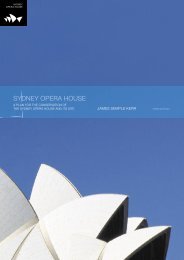nomination by the Government of Australia - Sydney Opera House
nomination by the Government of Australia - Sydney Opera House
nomination by the Government of Australia - Sydney Opera House
You also want an ePaper? Increase the reach of your titles
YUMPU automatically turns print PDFs into web optimized ePapers that Google loves.
10.3<br />
Ove Arup (1895–1988)<br />
Ove Nyquist Arup (Figure 10.2) was born in 1895<br />
at Newcastle-upon-Tyne, England. His mo<strong>the</strong>r was<br />
Norwegian and his Danish fa<strong>the</strong>r served for some<br />
time as <strong>the</strong> Danish <strong>Government</strong>’s veterinary <strong>of</strong>fi cer to<br />
<strong>the</strong> United Kingdom. Ove Arup attended schools in<br />
Germany and Denmark before studying philosophy<br />
and ma<strong>the</strong>matics at <strong>the</strong> University <strong>of</strong> Copenhagen<br />
where he graduated in 1916. From 1916–1922<br />
he studied civil engineering at <strong>the</strong> Royal Technical<br />
College, Copenhagen.<br />
Arup started work as a designer for <strong>the</strong> Danish civil<br />
engineering designers and contractors Christiani &<br />
Nielsen in 1922 in <strong>the</strong>ir <strong>of</strong>fi ce in Hamburg, Germany.<br />
He moved to London in 1923 and became Christiani<br />
& Nielsen’s chief designer in 1925. While his main<br />
activities were civil engineering (mainly marine<br />
structures) he became increasingly interested in<br />
architecture and <strong>the</strong> Modern Movement. He became<br />
friends with several leading architectural fi gures, joined<br />
<strong>the</strong> Architectural Association and became active in<br />
<strong>the</strong> Modern Architecture Research Society, known<br />
as <strong>the</strong> MARS Group. In 1933 Tecton (an architectural<br />
fi rm led <strong>by</strong> Berthold Lubetkin) invited Arup to work<br />
on Highpoint 1, an apartment block in London. Arup<br />
proposed <strong>the</strong> use <strong>of</strong> reinforced concrete (not generally<br />
used for multi-storey construction at that time) and a<br />
simplifi ed construction method using movable, reusable<br />
formwork. When Christiani & Nielsen decided not to<br />
proceed with <strong>the</strong> Highpoint project, Arup moved to<br />
Danish fi rm JL Kier & Co as director and chief designer<br />
on <strong>the</strong> condition that <strong>the</strong>y take over <strong>the</strong> project.<br />
Highpoint 1 came to symbolise some <strong>of</strong> <strong>the</strong> tenets <strong>of</strong><br />
<strong>the</strong> Modern Movement. Arup worked with Lubetkin<br />
on a number <strong>of</strong> o<strong>the</strong>r landmark projects including <strong>the</strong><br />
much admired Penguin Pool at <strong>the</strong> London Zoo.<br />
In 1938 Ove Arup founded two civil engineering<br />
companies with his cousin Arne Arup: Arup &<br />
Arup Ltd and Arup Designs Ltd. He resigned from<br />
Arup & Arup in 1946 to establish an independent<br />
engineering consultancy with <strong>of</strong>fi ces in London and<br />
Dublin. For a short period, he retained <strong>the</strong> right to <strong>the</strong><br />
registered name Arup Designs Ltd. In 1948 he took<br />
in three partners to found <strong>the</strong> practice <strong>of</strong> Ove Arup<br />
& Partners. By <strong>the</strong> mid-1950s Ove Arup & Partners<br />
was established and growing with a client base that<br />
included many <strong>of</strong> <strong>the</strong> major architectural practices in<br />
<strong>the</strong> British Isles. The fi rm had a particular interest in<br />
modern architecture. Its core activity was to pioneer<br />
advanced and economical solutions to buildings,<br />
particularly <strong>the</strong>ir structures.<br />
A key project was <strong>the</strong> Rubber Factory at Brynmawr,<br />
Wales (with <strong>the</strong> Architects Co-Partnership) that<br />
attracted world attention, especially for its ingenious<br />
ro<strong>of</strong> <strong>of</strong> nine shallow, long-span reinforced concrete<br />
shells. Arup’s credo <strong>of</strong> multidisciplinary collaboration<br />
found expression in <strong>the</strong> fi rm’s acquisition and<br />
development <strong>of</strong> all <strong>the</strong> skills necessary for <strong>the</strong> design <strong>of</strong><br />
buildings and civil engineering works.<br />
In 1957, Arup’s fi rm was appointed as <strong>the</strong> consulting<br />
engineers for <strong>the</strong> <strong>Sydney</strong> <strong>Opera</strong> <strong>House</strong> project. This<br />
led to a nine-year partnership between Utzon and<br />
Ove Arup & Partners that was to result in pioneering<br />
solutions to <strong>the</strong> many structural and architectural<br />
challenges <strong>of</strong> <strong>the</strong> project. The most remarkable aspect<br />
<strong>of</strong> this collaboration was <strong>the</strong> building <strong>of</strong> <strong>the</strong> iconic<br />
ro<strong>of</strong> structure. Between 1958 and 1962 Arup, his<br />
partners and staff collaborated intensively with Utzon<br />
in Denmark and London and developed a number<br />
<strong>of</strong> geometric shapes which resulted in a simplifi ed<br />
spherical geometry. This introduced <strong>the</strong> possibility for<br />
repetition in <strong>the</strong> manufacture <strong>of</strong> <strong>the</strong> precast elements<br />
for <strong>the</strong> ro<strong>of</strong>. Ove Arup & Partners also made extensive<br />
use <strong>of</strong> computers in <strong>the</strong> technical work associated<br />
with <strong>the</strong> design <strong>of</strong> <strong>the</strong> project. It was one <strong>of</strong> <strong>the</strong> fi rst<br />
applications <strong>of</strong> digital technology to building. After<br />
Utzon’s departure in 1966 <strong>the</strong> fi rm worked with his<br />
successors Hall, Todd & Littlemore until completion <strong>of</strong><br />
<strong>the</strong> <strong>Sydney</strong> <strong>Opera</strong> <strong>House</strong> in 1973.<br />
Figure 10.3 Ove Arup<br />
105

















